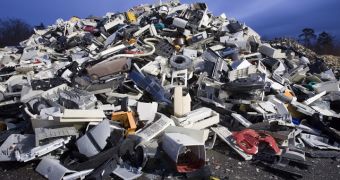A new report issued as part of the UN's Solving the E-Waste Problem (StEP) Initiative says that, by the year 2017, the world will produce some 64.5 million tonnes of e-waste annually.
To put things into perspective, it must be said that the combined weight of all this e-waste will rival that of 200 Empire State Buildings or 11 Great Pyramids of Giza put together.
For those who relate better to volume than they do to weight, here is one other way to look at things: the refrigerators, TVs, computers and the like that people will dispose of on a yearly basis by 2017 will likely be more than enough to fill 40-ton trucks standing one behind the other on a highway that covers three quarters of the Equator.
According to EurekAlert, the amount of e-waste the world is expected to roll out annually in the not so distant future represents a 33% increase when compared to how many end-of-life fridges, computers, mobile phones and whatnot currently hit landfills.
Thus, information collected as part of the StEP Initiative says that, in 2012 alone, some 48.9 million metric tons of e-waste were disposed of.
This means that, on average, each of the planet's 7 billion inhabitants said goodbye to 7 kilograms (15.4 pounds) of electrical and electronic equipment.
In the same year, the US produced 9.4 million tons of e-waste. The country was followed closely by China, whose e-waste output amounted to 7.3 million tons.
Interestingly enough, the US was not the worst of the bunch merely because it produced the world's highest volume of e-waste, but also because the average American was responsible for 29.8 kilograms (65.7 pounds) of high-tech trash in said year.
By comparison, the average Chinese only produced 5.4 kilograms (11.9 pounds) of electrical and electronic equipment.
Under a business-as-usual scenario, odds are that these two countries will remain the world's leaders in terms of e-waste generation.
Together with this report concerning global e-waste generation, the StEP Initiative released an interactive map, i.e. the StEP E-Waste World Map, that documents how much 184 countries contribute to the world's high-tech trash output.
“Though there is considerable knowledge about the negative environmental and health impacts through primitive recycling methods, a better information about the quantitative and qualitative dimensions associated with the e-waste problem would make it more understandable and be more useful in order to better inform policy making at the private and public levels,” the folks behind this project explain.
Furthermore, “This first-of-a-kind e-waste world-map provides comparable, country-level data on the amount of electrical and electronic equipment put on the market and the resulting amount of e-waste generated in most countries around the world.”

 14 DAY TRIAL //
14 DAY TRIAL //